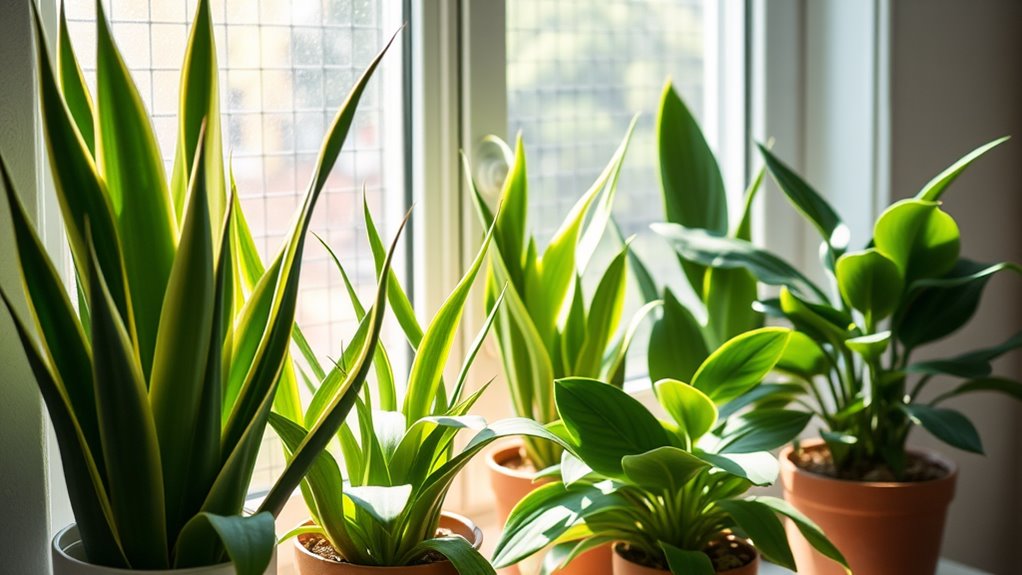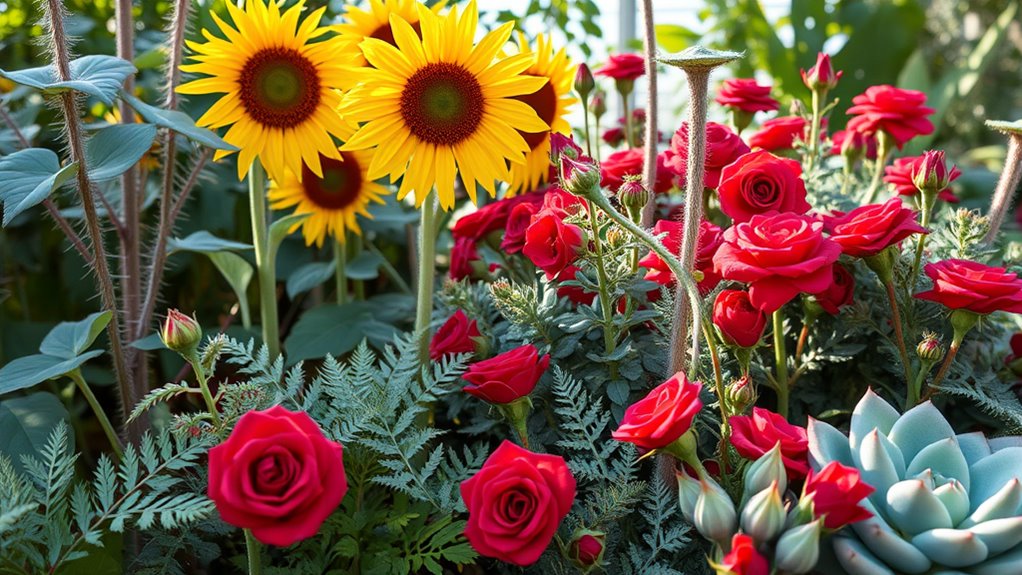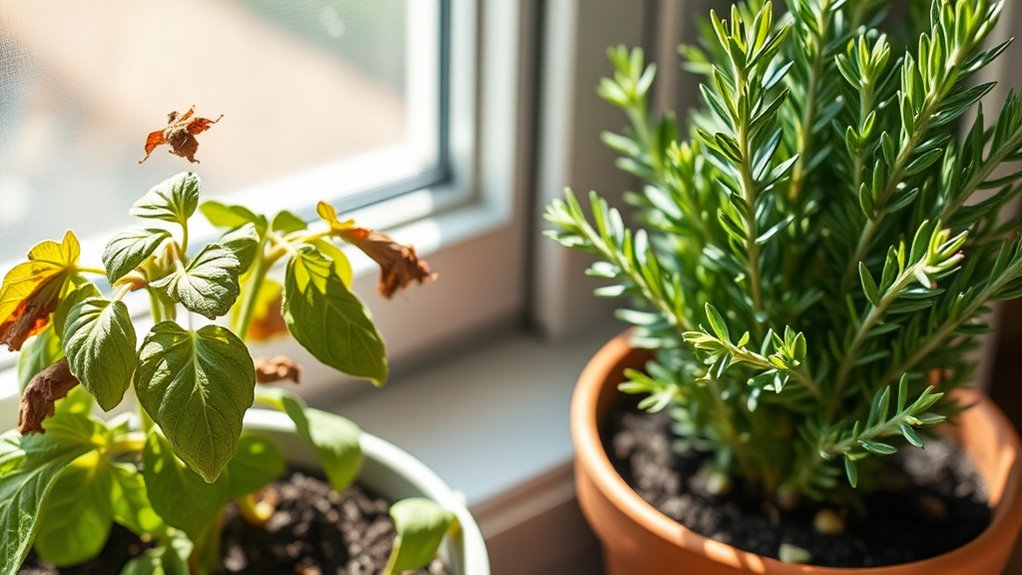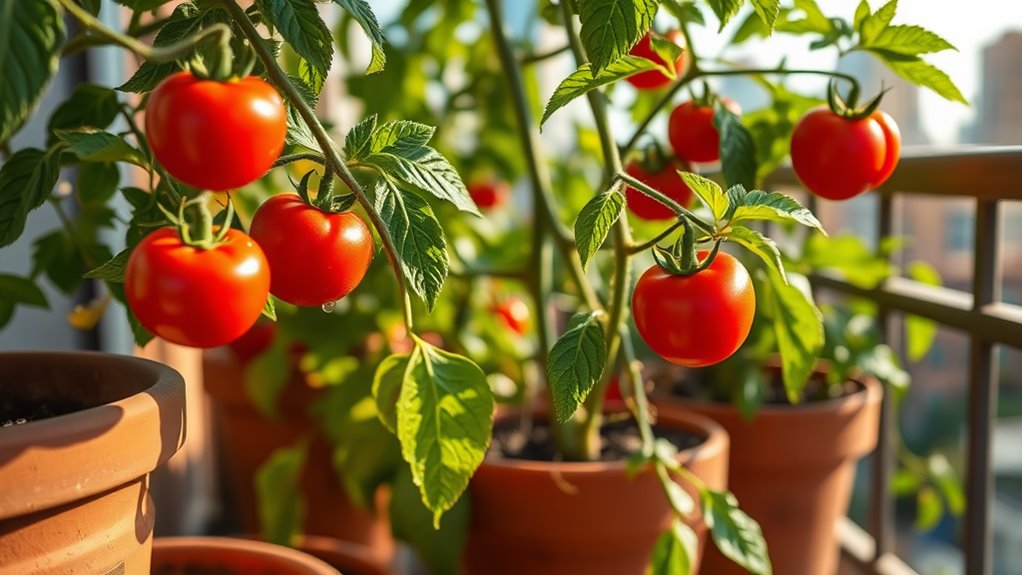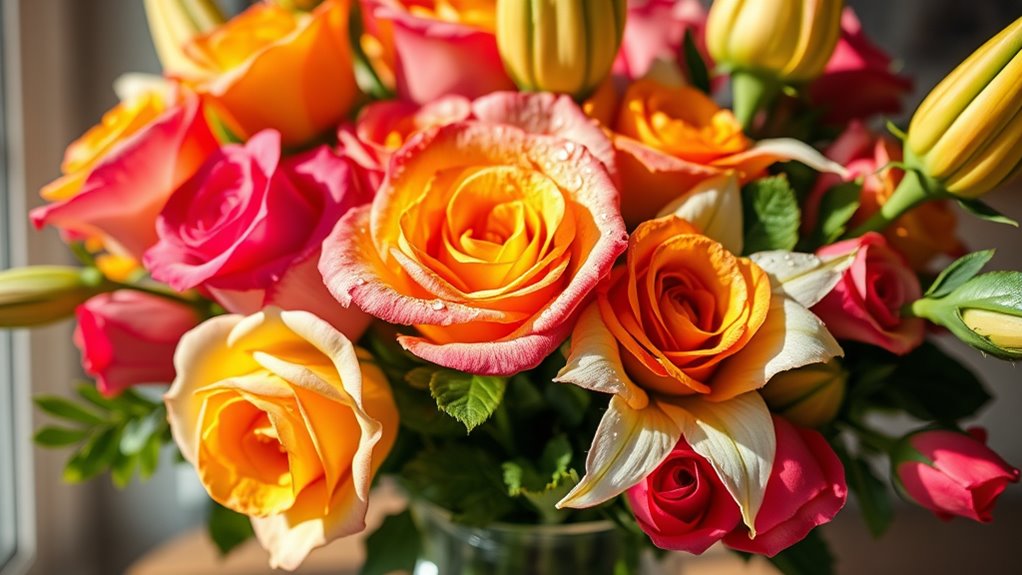Indoor Plants That Thrive on Neglect – Perfect for Busy People
If you’re juggling a busy life, opt for hardy indoor plants like the snake plant, which needs water just every two to three weeks and thrives in low light. The ZZ plant survives on monthly watering, while pothos forgives missed sessions and adapts easily. Succulents such as aloe vera store water for drought resistance, and the cast iron plant handles neglect in shady spots. Discover additional low-maintenance favorites to effortlessly green your space.
Key Takeaways
- Snake Plants thrive in low light and require watering only every 2-3 weeks.
- ZZ Plants need minimal care, with watering once a month in low light.
- Pothos adapts to various conditions, tolerating missed waterings easily.
- Aloe Vera stores water in its leaves, needing sparse watering every 2-3 weeks.
- Spider Plants handle inconsistent watering and propagate effortlessly.
Snake Plant: The Ultimate Survivor
If you’re a busy professional with little time for plant care, the Snake Plant is your go-to survivor.
As a top choice among low-maintenance indoor plants, it thrives in low light and dry conditions, requiring water just once every two to three weeks. You tolerate its neglect easily, as it purifies your air by removing toxins like formaldehyde. The Snake Plant is one of the five resilient indoor plants featured in selections for busy individuals.
Place it in corners or on desks for a sleek, vertical accent that boosts your space without fuss. Its hardy nature means you simply dust leaves periodically and enjoy its resilience year-round.
This plant is part of a broader selection of effortless indoor plants perfect for enhancing living spaces with minimal effort.
ZZ Plant: Minimal Watering Wonders
The ZZ Plant, a resilient favorite for those with hectic schedules, thrives on minimal watering—typically just once a month—while tolerating low light with ease. As one of the resilient indoor plants featured in beginner guides, it’s an excellent starting point for novice gardeners looking to build confidence.
You’ll appreciate its glossy, dark green leaves that add a touch of elegance to any room without demanding attention.
If you’re forgetful, don’t worry; it stores water in its rhizomes, making it drought-resistant and ideal for travel.
Propagate it simply by dividing the roots during repotting, every few years.
Watch for pests like spider mites, but they’re rare in stable conditions.
This plant boosts your space’s air quality effortlessly, fitting your busy life perfectly.
To keep it thriving without issues, incorporate simple indoor pest control techniques into your routine.
Pothos: Versatile and Forgiving Foliage
You thrive with pothos because it’s adaptable to various light and temperature conditions in your home.
You’ll appreciate its forgiving watering schedule, letting you go longer between drinks without worry.
This makes pothos a practical choice for your busy lifestyle, ensuring lush foliage with minimal effort. This aligns with essential tips for beginner gardens, emphasizing plant selection to ensure success.
Additionally, Pothos is celebrated in beginner gardening resources for its low maintenance requirements that make it ideal for novice gardeners.
Versatile Growth Conditions
Pothos plants thrive in diverse conditions, making them ideal for busy lifestyles due to their remarkable adaptability. You’ll appreciate how they fit seamlessly into your home, tolerating various environments without fuss.
-
Light Tolerance: They flourish in low to bright indirect light, so you can place them in dimly lit corners or sunnier spots.
-
Temperature Range: Pothos handles 60-85°F (15-29°C), adapting to your indoor climate without special heating or cooling.
-
Humidity Levels: They’re forgiving in both dry air and higher humidity, perfect for any room in your house.
-
Placement Flexibility: Grow them on shelves, in hanging pots, or on tables, as they climb or trail effortlessly.
Forgiving Watering Schedule
One key advantage of Pothos plants is their forgiving watering needs, allowing you to skip rigid schedules without worry. This means you don’t have to stress over precise timing; just check the soil’s top inch for dryness before watering deeply. Pothos tolerates missed waterings well, recovering quickly from neglect, which suits your busy life perfectly.
| Watering Aspect | Key Indicators | Practical Advice |
|---|---|---|
| Frequency | Soil dry (1-2 weeks) | Water thoroughly, then wait |
| Underwatering | Wilted or crisp leaves | Hydrate immediately |
| Overwatering | Yellowing, soggy soil | Allow soil to dry out |
| Recovery Tips | New growth after care | Trim damaged leaves |
Succulents: Drought-Resistant Delights
As drought-resistant wonders, succulents thrive with minimal watering, making them ideal for your hectic schedule.
They’re perfect for adding low-maintenance greenery to your space, storing water in their fleshy leaves to withstand neglect.
Plus, they enhance air quality and decor without demanding much attention, fitting seamlessly into busy lifestyles. Additionally, by exploring effortless herb gardening, you can enjoy fresh herbs that require minimal upkeep and enhance your meals with vibrant flavors.
For those expanding their collection, consider incorporating resilient herbs that flourish with minimal care, much like succulents.
- Select hardy varieties like aloe or jade for easy adaptation.
- Position in bright, indirect light to mimic natural conditions.
- Water only when soil is fully dry to prevent overwatering issues.
- Use well-draining pots and soil to promote root health and longevity.
Spider Plant: Effortless Growth and Spread
You’ll love how the spider plant fits your busy routine with its easy propagation, letting you create new plants from simple offsets in minutes.
It’s a breeze to multiply your collection without fancy tools or much effort.
Best of all, its low water needs mean you can water it sparingly and still enjoy lush growth.
Moreover, as an effortless plant for beginner gardeners, it thrives with minimal attention while offering additional benefits like air purification.
[LIST OF 3 SUBHEADING DISCUSSION POINTS IN ENGLISH
The Spider Plant stands out for busy individuals seeking low-maintenance greenery, as its effortless growth and spread make it ideal for any indoor space.
You’ll appreciate how it flourishes with little effort, tolerating neglect while enhancing your home’s ambiance.
-
Adapt to various light levels****: Position it in low or bright indirect light; it adjusts quickly without wilting.
-
Handle inconsistent watering****: Let soil dry between waterings; it bounces back from occasional misses.
-
Resist pests naturally: Its leaves deter common insects, reducing your intervention needs.
-
Boost room aesthetics: Watch it produce arching leaves and baby plants that spread gracefully, adding visual interest effortlessly.
Easy Propagation
One key advantage of the Spider Plant is its simple propagation, where you snip off the baby plantlets, called spiderettes, and root them in water or soil to create new plants effortlessly. This process suits your busy life, as it requires minimal time and yields quick results. You’ll expand your collection cost-effectively, turning one plant into many with ease.
Here’s a breakdown to guide you:
| Method | Steps | Benefits |
|---|---|---|
| Water | Snip spiderette and submerge | Fast root development |
| Soil | Snip and plant in pot | Direct, stable growth |
| Division | Separate offsets carefully | Instant multiple plants |
| Timing | Choose spring for best results | Higher success rate |
| Tools | Use clean scissors only | Keeps it simple and hygienic |
Low Water Needs
While many indoor plants require frequent watering, spider plants thrive with minimal moisture, making them ideal for your hectic schedule.
You’ll appreciate how these resilient plants adapt to dry conditions, reducing your maintenance efforts while keeping spaces vibrant.
-
Water sparingly: Allow the top inch of soil to dry out between waterings, typically every 1-2 weeks, to mimic their natural drought tolerance.
-
Choose the right soil: Opt for well-draining mixes that prevent root rot, ensuring your spider plant stays healthy with less intervention.
-
Monitor humidity: Place them in average indoor conditions; they don’t need extra humidity, simplifying your care routine.
-
Observe for signs: Yellow tips indicate overwatering, so adjust immediately to maintain effortless growth and spread.
Peace Lily: Thrives on Occasional Care
Peace lilies thrive on neglect, making them perfect for your hectic lifestyle. They tolerate low light and infrequent watering, purifying your air while adding elegant blooms to your space with minimal effort. To enhance their growth naturally, incorporate organic tips from sustainable practices.
Here’s how peace lilies evoke your emotional connection:
| Aspect | Emotional Benefit | Practical Tip |
|---|---|---|
| Air Purification | Feel calmer and refreshed | Water when soil is dry |
| Low Maintenance | Boost your daily serenity | Wipe leaves for vibrancy |
| Aesthetic Charm | Inspire a sense of peace | Place in indirect light |
| Resilient Growth | Foster pride in your space | Repot every 1-2 years |
Embrace this plant to reduce stress and enhance your home effortlessly. Backed by scientific studies, peace lilies effectively improve indoor air quality by removing harmful toxins.
Aloe Vera: Healing Benefits With Little Effort
Aloe vera delivers healing benefits with minimal upkeep, thriving in your busy routine as a resilient succulent.
It’s a hardy plant that fits seamlessly into your life, needing only occasional watering and bright, indirect light to flourish while offering natural remedies for skin issues.
-
Water sparingly: Let the soil dry out completely between waterings—every 2-3 weeks—to prevent root rot and keep it thriving with ease.
-
Harvest for healing: Snap off a leaf for fresh gel to soothe burns, cuts, or irritations, turning your plant into a handy home first-aid kit.
-
Adapt to light: Position it in a sunny spot without direct harsh rays, allowing it to grow strong with minimal adjustments.
-
Boost well-being: Enjoy improved air quality as it filters toxins, all while requiring little more than your occasional glance.
Similar to growing fresh herbs indoors, Aloe Vera can enhance your indoor space with its easy-care nature and additional health perks.
Cast Iron Plant: Indestructible Indoor Greenery
You’ll appreciate the Cast Iron Plant’s remarkable low light tolerance, allowing it to flourish in your shaded corners without extra effort.
It thrives with minimal watering, so you can go weeks without checking the soil and still keep it healthy.
This hardy choice lets you enjoy greenery that demands little from your packed schedule.
Low Light Tolerance
For those with dimly lit spaces, the Cast Iron Plant thrives effortlessly, making it an ideal pick for low-light conditions.
You’ll appreciate its resilience in shaded areas, where it flourishes with minimal effort, enhancing your home’s ambiance without demanding bright rays.
-
Select shady spots****: Position it in low-light rooms like hallways or offices to leverage its natural tolerance.
-
Monitor growth patterns: Watch for steady, dark green leaves that indicate it’s adapting well to your dim environment.
-
Avoid direct sun: Keep it away from windows to prevent leaf burn, ensuring long-term health.
-
Pair with decor: Integrate it into your space for aesthetic appeal, as it complements furniture without needing adjustments.
Minimal Watering Needs
One of the Cast Iron Plant’s standout features is its minimal watering needs, making it ideal for your busy lifestyle. This hardy plant thrives with watering every 2-4 weeks, tolerating dry soil to prevent root rot and save you time. Unlike finicky greens, it forgives neglect, focusing your efforts elsewhere. Here’s a practical breakdown to guide you:
| Aspect | Key Details | Practical Tips |
|---|---|---|
| Watering Frequency | Every 2-4 weeks | Check soil; water if dry 2 inches down |
| Water Amount | Moderate, until it drains | Use room-temperature water |
| Soil Moisture | Prefers slightly dry | Allow topsoil to dry out fully |
| Signs of Thirst | Yellowing or drooping leaves | Water immediately, then monitor |
| Long-Term Benefits | Reduces maintenance stress | Pair with well-draining pots for health |
Heartleaf Philodendron: Adaptable and Hardy
Among indoor plants, the Heartleaf Philodendron stands out for its remarkable adaptability and hardiness, making it a top pick for your busy lifestyle.
You’ll appreciate how it thrives in various conditions with minimal effort, tolerating neglect while adding lush greenery to your space.
-
Adapts to low light****: Flourishes in dim corners where other plants struggle, reducing your need for adjustments.
-
Handles irregular watering****: Bounces back from dry spells, ideal if you forget routines.
-
Resists common pests: Its hardy leaves deter insects, saving you maintenance time.
-
Easily propagates: Simply snip a stem to grow new plants, expanding your collection effortlessly.
Jade Plant: Simple Succulent Success
The Jade Plant stands as a resilient succulent that flourishes with little fuss, ideal for your demanding routine.
You’ll thrive with it in bright, indirect light, watering only when the soil dries out completely—typically every 2-3 weeks.
This low-maintenance gem tolerates occasional missed waterings, storing water in its thick leaves to survive neglect.
Propagate easily by taking stem cuttings; just let them callous before planting.
Watch for pests like mealybugs, but they’re rare with good air circulation.
Its coin-shaped leaves add aesthetic appeal and even symbolize prosperity, boosting your space without extra effort.

